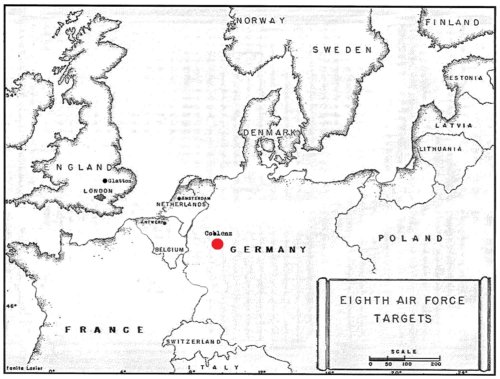TARGET: COBLENZ
COBLENZ, GERMANY
24 DECEMBER, 1944
The Eighth Air Force was unable to cope with the weather. 20 December to 23 December was a repeat of 16 to 18 December. A relentless and stubborn fog had moved in and had accomplished what the German Luftwaffe had been unable to do, keep the bombers on the ground.
The ground troops were desperate for air support. That was to finally come on Christmas Eve, when the Air Force meteorologists predicted a break in the weather. The Eighth Air Force planned what would be the largest air assault in the history of air warfare, 2,000 heavy bombers, plus fighter and other support units, with all groups putting up all airworthy planes. The 457th responded with 45 bombers. The assigned target was Coblenz, Germany. The 457th was to comprise the lead, low and high squadrons of the 94th A Combat Group, flying ninth in Division formation. The Air Commander was Captain Doherty with Captain Seesenguth as pilot.
Despite the meteorologists’ predictions, the weather on Christmas Eve was just as miserable as the days before, snowing, foggy, with a coldness that penetrated the skin. In early morning, just before six o’clock, two bombs (V-I’s) dropped south of the base, apparently intended for a nearby munitions plant. The explosion shook the base.
The crews flying the mission had an early morning briefing and proceeded to the planes. However, takeoff was delayed due to the weather. At 1024 hours, the planes did begin taking off. Six planes were airborne before the craft piloted by Lt. Carl P. Sundbaum crashed on takeoff,, claiming the life of one crew member. The explosion rocked the base for the second time that day. The crash closed the runways, because it was not visible in the fog, and crash equipment had difficulty finding it in the field off the end of the runway.
Two of the Group aircraft, having been diverted from the previous mission, took off from other bases and joined the six craft already airborne from Glatton. The eight craft assembled on the Glatton Buncher at 7,000 feet and continued to circle it, waiting for the other craft to assemble. Word was then received from the tower that the mission had been scrubbed and to proceed to Ridgewell and land. A little later a stand by was received and shortly thereafter the eight were directed to form with the 401St Bomb Group, and proceed with the mission. They were to fly as high-high squadron with the 40 1st.
The aircraft took interval behind the high squadron of the 40 1st Group, but the high-high lead craft was forced to abort after having been hit by antiaircraft fire, and turned the lead over to the No.3 position (the deputy was not able to take over because of mechanical difficulties). Because of this, the section became separated from the 401st and was not able to maintain formation.
A visual run was made on Coblenz. There was about one-tenth cloud coverage and visibility was fair. The MPI was not actually sighted because it was obscured by smoke and clouds, and bombing was done by triangulation, the bombs being released from 26,000 feet. No other difficulties were encountered. The lead craft attacked a target of opportunity and returned to base Individually.
The other seven aircraft, being unable to rally with the 40lst,joined the 398th Group formation and flew the return route without incident. All aircraft were diverted to other bases because of local weather conditions. A normal let down was made and they landed without further difficulty.
Thirty-four aircraft took off in the afternoon and assembled on the Glatton Buncher at 7,000 feet. No difficulties were encountered.
No Division assembly was accomplished. Because of the late takeoff, word was received to proceed to the Channel and jettison bombs in order to return to base by 1700 hours. After releasing bombs, the Group executed a 180 degree turn and flew back to the Glatton Buncher.
One crew went into enemy territory alone and bombed Daun, a target of opportunity.
Because of local weather conditions, all aircraft were diverted to Eye and Horham, where the crews spent a rather miserable Christmas.
Three craft that had been diverted from the 19 December mission departed from Knettishell and bombed with the 3 88th Bomb Group.
The Eighth Air Force was led on the mission by General Frederick W. Castle, Commanding Officer of the 4th Combat Wing. As General Castle’s plane neared the front battle lines of the ground forces, No. 4 engine began to give trouble. A short time later a swarm of Me-I 09s appeared and attacked. No longer able to maintain its lead position, the plane pulled out of formation and was attacked again by the Me-I 09s. With the full bomb load still being carried; General Castle attempted to fly the plane to a spot where no damage could occur to Allied troops. The plane exploded and crashed in Belgium, killing General Castle and the pilot. For gallantry in action, above and beyond the call of duty, General Castle was awarded the Medal of Honor posthumously.
Lt. Edwin B. Benson, 457th/749th bombardier: Mission 20. Coblentz. R.R. yards. Time 8.10. High. Lead. FLAK and one jet fighter
